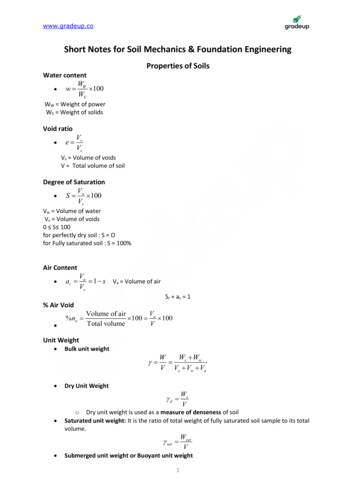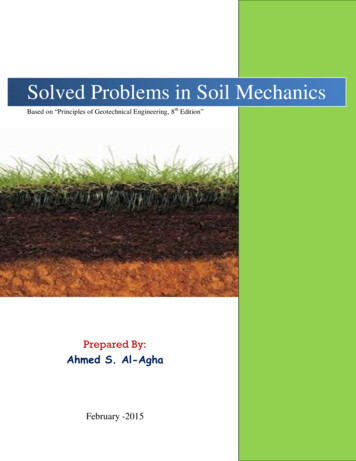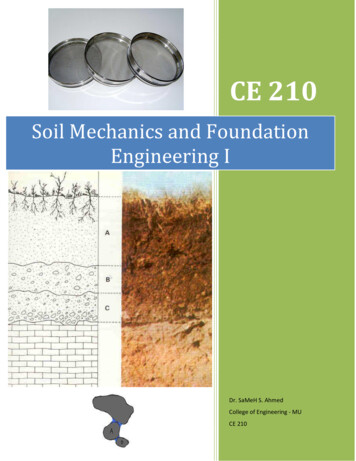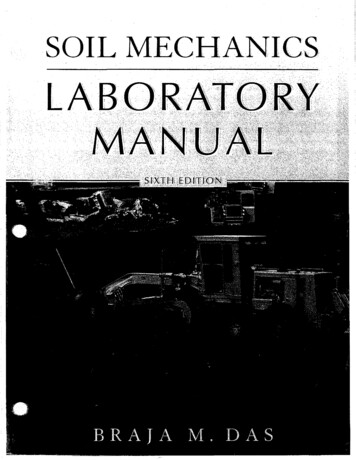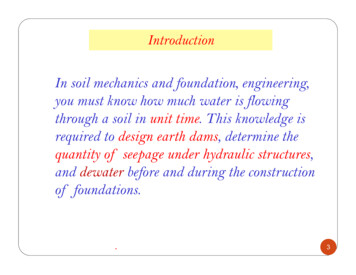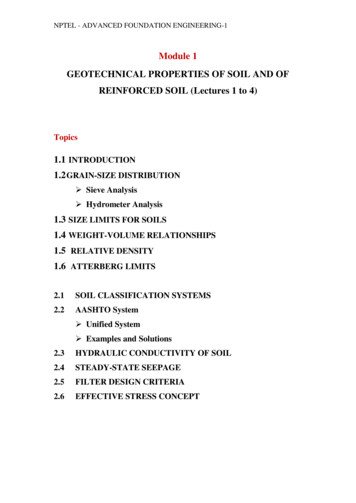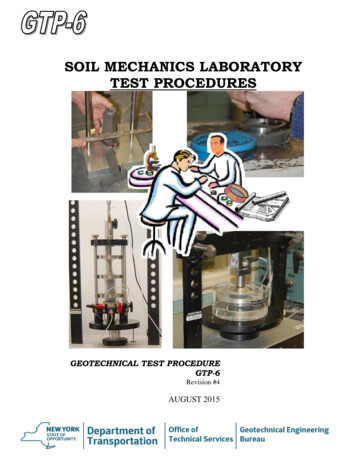
Transcription
CEng 487 - SOIL MECHANICS IILecture NotesChapterChapterChapterChapter1:2:3:4:Shear Strength of Soils.Bearing Capacity of Shallow Foundations.Lateral Earth Pressure.Slope Stability.References:1. Teferra, A. & Mesfin, L., 1999. Soil Mechanics, AAU2. Budhu M., 2000. Soil Mechanics and Foundations, Wiley and Sons.3. Cernica, J. N., 1995. Geotechnical Engineering - Soil Mechanics, Wiley and sons.4. Prakash, S., 1995. Fundamentals of Soil Mechanics, Prakash Foundation.5. Das, B. M., 1995. Principles of Foundation Engineering, PWS pub. Co.6. Bowles, J. E., 1996. Foundation Analysis and Design, Joseph E. Bowles, McGraw-Hill.
Addis Ababa University, Faculty of Technology, Department of Civil EngineeringCHAPTER ONESHEAR STRENGTH OF SOILS1.0IntroductionThe safety of any geotechnical structure is dependent on the strength of the soil. Ifthe soil fails, a structure founded on it can collapse, endangering lives and causingeconomic damages. Soils fail either in tension or in shear. However, in the majority of soilmechanics problems (such as bearing capacity, lateral pressure against retaining walls,slope stability, etc.), only failure in shear requires consideration. The shear strength ofsoils is, therefore, of paramount importance to geotechnical engineers. The shearstrength along any plane is mobilized by cohesion and frictional resistance to slidingbetween soil particles. The cohesion c and angle of frictionφof a soil are collectivelyknown as shear strength parameters.In this chapter we will define, describe, and determine the shear strength of soils.When you complete this chapter, you should be able to: Determine the shear strength of soils. Understand the difference between drained and undrained shear strength. Determine the type of shear test that best simulates field conditions. Interpret laboratory and field test results to obtain shear strengthparameters.Sample Practical Situation: You are the geotechnical engineer in charge of a soilexploration program for a dam and a housing project. You are expected to specifylaboratory and field tests to determine the shear strength of the soil and to recommendsoil strength parameters for the design of the dam.1.1Definitions of Key TermsShear strength of a soil ( τ ) is the maximum internal resistance to applied shearingstresses.Angle of internal friction ( φ ) is the friction angle between soil particles.Cohesion (c) is a measure of the forces that cement soil particles.Undrained shear strength of a soil (Su) is the shear strength of a soil when sheared atconstant volume.Soil Mechanics II: Lecture NotesInstructor: Dr. Hadush Seged1
Addis Ababa University, Faculty of Technology, Department of Civil Engineering1.2Coulomb’s Frictional LawYou may recall Coulomb’s frictional law from your courses in statics and physics. Ifa block of weight W is pushed horizontally on a plane (Fig. 1.1a), the horizontal force (H)required to initiating movement is:H µWWhereµ(1.1)is the coefficient of static friction between the block and the horizontal plane.The coefficient of frictionµis independent of the area of contact. It is, however,strongly dependent on the nature of the surface in contact – the type of material, thecondition of the surface, and so on. Furthermore, in most materials the coefficient ofstatic friction is larger than the kinetic coefficient. The angle between the resultant forceR and the normal force N (Fig. 1.1) is called the friction angle,φ tan 1 µ .Figure 1.1: (a) Slip plane of a block. (b) A slip plane in a soil mass.In terms of stresses, Coulomb’s law is expressed as:τ f σ n tan φwhereτf(1.2)( T/A, where T is the shear force at impending slip and A is the area of theplane parallel to T) is the shear stress when slip is initiated, andσ n ( N/A) is the normalstress on the plane on which slip is initiated. Coulomb’s law requires the existence or thedevelopment of a critical sliding plane, also called slip plane or failure plane. In the caseof the block the slip plane is at the interface between the block and the horizontal plane.1.3Mohr’s Circle for StressThe stress states at a point within a soil mass can be represented graphically by avery useful and widely used devise known as Mohr’s circle for stress. The stress state ata point is the set of stress vectors corresponding to all planes passing through that point.For simplicity, we will consider a two-dimensional element with stresses as shown in Fig.Soil Mechanics II: Lecture NotesInstructor: Dr. Hadush Seged2
Addis Ababa University, Faculty of Technology, Department of Civil Engineering1.2a. Let’s draw Mohr’s circle. First, we have to choose a sign convention. In soilmechanics, compressive stresses and clockwise shear are generally assumed to bepositive. We will also assume that σ z σx.Figure 1.2: Stresses on a two-dimensional element and Mohr’s circle.The two coordinates of the circle are ( σ z ,τ zx ) and ( σ x , τ zx ). Recall from yourstrength of materials course that, for equilibrium τ xz τ zx . Plot these two coordinateson a graph of shear stress (ordinate) and normal stress (abscissa) as shown by A and Bin Fig. 1.2b. Draw a circle with AB as the diameter. The circle crosses the normal stressaxis at 1 and 3, where shear stresses are equal to zero. The stresses at these points arethe major principal stress, σ 1 , and the minor principal stress,The principal stresses are related to the stressesσ3.σ x ,σ zandτ zxby the followingrelations:σ z σ xσ1 σ3 2σz σx2 σ σ x 2 z τ zx2 (1.3) σ σ x 2 z τ zx2 (1.4)22The angle between the major principal stress plane and the horizontal plane (ψ ) is:tanψ τ zxσ1 σ xThe stresses on a plane oriented at an angleσθ Soil Mechanics II: Lecture Notesσ1 σ 32 θ(1.5)to the major principal stress plane are:σ1 σ 32cos 2θ(1.6)Instructor: Dr. Hadush Seged3
Addis Ababa University, Faculty of Technology, Department of Civil Engineeringτθ In the above equationsθσ1 σ 32sin 2θ(1.7)is positive for clockwise orientation. The maximum shearstress is at the top of the circle with magnitude:τ max The stressσzσ1 σ 3(1.8)2acts on the horizontal plane and the stressσxacts on the verticalplane. If we draw these planes in Mohr’s circle, they intersect at a point, P. Point P iscalled the pole of the Mohr circle. It is a special point because any line passing throughthe pole will intersect Mohr’s circle at a point that represents the stresses on a planeparallel to the line. Let us see how this works. Suppose we want to find the stresses ona plane inclined at angleθto the horizontal plane as depicted by MN in Fig. 1.2a. Oncewe locate the pole, P, we can draw a line parallel to MN through P as shown by M’N’ in Fig.1.2b. The line M’N’ intersects the circle at N’ and the coordinates of N’, ( σ θ ,τ θ ) representthe normal and shear stresses on MN.EXAMPLE 1.1A sample of soil 100 mmDetermine (a) σ 1 , σ 3 and 100 mm is subjected to the forces shown in Fig. E1.1a.ψ; (b) the maximum shear stress, and (c) the stresses on a0plane oriented at 30 clockwise to the major principal stress plane.Figure E1.1aStrategy. There are two approaches to solve this problem. You can either use Mohr’scircle or the appropriate equations. Both approaches will be used here.1.4Mohr-Coulomb Failure CriteriaCoulomb (1776) suggested that the shear strength of a soil along a failure planecould be described by:τ f c σ n tan φwhereτfis the shear strength on the failure plane,plane, c is the cohesion andparameters c andφφ(1.9)σnis the stress normal to thethe angle of internal friction of the soil. The twoare called shear strength parameters.To understand the concept behind Eq. (1.9), consider two blocks A and B (Fig.Soil Mechanics II: Lecture NotesInstructor: Dr. Hadush Seged4
Addis Ababa University, Faculty of Technology, Department of Civil Engineering1.3a) of unit area that are in contact with each other and are subjected to the normal andshear stresses shown. The interface between the blocks is not smooth and containsfriction. Under a constant normal stress, the shear stress is increased from zero to themaximumτf, forcing the two blocks to slide along their contact area. Whenσ n 0, theshear stress has to be mobilized to a maximum value of c to make the sliding possible. Ifthe friction angle between blocks A and B isφthen for the values ofincreased to overcome the resistance to slidingσ tan φσ 0,τhas to becaused by friction (Coulomb’sfrictional law). Consequently, the summation of c andσ tan φrepresents themaximum shear stress needed to slide the two blocks on the plane of contact (slip orfailure plane). In a real soil, if a predetermined sliding plane is forced to occur, the soilbelow and the soil above the failure plane will not act as rigid bodies but will deform,causing a volume change around the sliding and forming a shear band (Fig. 1.3b).Figure 1.3: (a) Mechanical concept of sliding. (b) Soil deformation and a shear band.In a coordinate system withσnplotted as abscissa andτas ordinate, Eq. (1.9)is represented by the line shown in Fig. (1.4a). This equation was originally written interms of total stress and was only partially successful in predicting the shear strength ofreal soils. Coulomb’s failure criterion was subsequently redefined as:τ f c ' σ n' tan φ '(1.10)Figure 1.4: Coulomb’s failure criteria: (a) total stress (b) effective stress.Soil Mechanics II: Lecture NotesInstructor: Dr. Hadush Seged5
Addis Ababa University, Faculty of Technology, Department of Civil Engineeringwhereτfis the shear strength,cohesion, andφ'σn ’is the effective normal stress, c’ is the effectivethe effective angle of internal friction of the soil. In both the total andeffective stress conditions, the shear stress is solely taken by the soil particles, since theliquid in the voids – which is normally water – has no resistance to shear. The tensilestrength of soils is commonly ignored and therefore cohesion is the minimum shearstrength at zero normal stresses.Figure 1.5: Mohr-Coulomb failure criterion.Figure 1.5 shows the total and effective stress states at failure point representedby Mohr’s circles. It is apparent that the shear stress at every plane in the total stressMohr’s circle is the same as in the effective stress Mohr’s circle. The difference betweennormal stresses in two perpendicular directions in the total and effective stress is equalto:σ z σ x (σ z' u ) (σ x' u ) σ z' σ x'(1.11)Thus, the radiuses of both the total and effective stresses are identical. The horizontaldistance of the two circles is equal to the pore water pressure u.Any point F at the failure plane represents the normal and shear stresses on afailure plane at a specified point in a soil. These stresses must also satisfy the equilibriumconditions at the point, which is represented by Mohr’s circle of stress. This implies that,at failure, Mohr’s circle of stress must be tangent to the line expressed by Eq. 4.9 (or4.10). This condition known as the Mohr-Coulomb failure criterion is shown in Fig. 1.5.From geometry of Fig. 1.5, the theoretical angle between the failure plane and themajor principal plane is given by the following equation: 90 φ ' φ'0 α 45 2 2 Soil Mechanics II: Lecture Notes(1.12)Instructor: Dr. Hadush Seged6
Addis Ababa University, Faculty of Technology, Department of Civil EngineeringFrom figure 1.5, a relationship between the state of stress ( σ 1 and'( σ , σ , or'x'zτ zx )φ’and the shear strength parameters c and'σ 3' )ormay be formulated byequating the radius of Mohr’s circle R to the distance of the center of the circle from thefailure envelope, CF,in which,R CF σ z' σ x' 2 2 τ zx2 OB cos φ ' OC sin φ ' This equation can be written in terms of the principal stresses ( τ zx σ 1' σ 3' 2 Considering OB c’ and OC (1.13) 0 ) as follows:2 OB cos φ ' OC sin φ '(1.14)(σ 1' σ 3' ) 2 , we haveσ 1' σ 3' 2c ' cos φ ' (σ 1' σ 3' ) sin φ '(1.15)Or,σ 1' σ 3'''1 sin φcos φ ''' 1 sin φ' 1 sin φσσ 2c ' 2c131 sin φ1 sin φ '1 sin φ '1 sin φ ' σ 3' σ 1''1 sin φ '' 1 sin φ 2c1 sin φ '1 sin φ '(1.16)(1.17)Or using some trigonometry manipulations,σ 1' σ 3' tan 2 (45 σ 3' σ 1' tan 2 (45 φ'2φ'2) 2c ' tan(45 ) 2c ' tan(45 φ'2φ'2)(1.18))(1.19)If the cohesion c’, is small or zero, then Eqs. (1.15 to 1.19) can be rearranged as follows: σ ' σ 3' sin φ ' 1'' σ1 σ 3 σ 3' 1 sin φ ' σ 1' 1 sin φ 'σ 3'φ'2 tan (45 )2σ 1'oror(1.20)σ 1' 1 sin φ ' σ 3' 1 sin φ 'σ 1'φ'2 tan (45 )2σ 3'(1.21)(1.22)EXAMPLE 1.2At a point in a soil mass, the total vertical and horizontal stresses are 240 kPa and 145Soil Mechanics II: Lecture NotesInstructor: Dr. Hadush Seged7
Addis Ababa University, Faculty of Technology, Department of Civil EngineeringkPa respectively whilst the pore water pressure is 40 kPa. Shear stresses on the verticaland horizontal planes passing through this point are zero. Calculate the maximum excesspore water pressure to cause the failure of this point. What is the magnitude of the shearstrength on the plane of failure? The effective shear strength parameters are c’ 10 kPaandφ ' 300.Strategy. You are given the initial stress state. You should first check whether the initialstress state is below the failure envelope, and then use the appropriate equations tocalculate the excess pore water pressure and the shear strength at failure.1.5Drained and Undrained Shear strengthDrained condition occurs when the excess pore water pressure developed duringloading of a soil dissipates, i.e. u 0 , resulting in volume changes in the soil. Loosesands, normally consolidated clays and lightly overconsolidatedclays tend to compressor contract, whilst dense sands and heavily overconsolidated (OCR 2) clays tend toexpand during drained condition.Undrained condition occurs when the excess pore water pressure cannot drain, atleast quickly from the soil, i.e. u 0 . During undrained shearing, the volume of the soilremains constant. Consequently, the tendency towards volume change induces apressure in the pore water. If the specimen tends to compress or contract during shear,then the induced pore water pressure is positive. It wants to contract and squeeze waterout of the pores, but it can not. Positive pore water pressures occur in loose sands,normally consolidated clays and lightly overconsolidated clays. If the specimen tends toexpand and swell during shear, the induced pore water pressure is negative. It wants toexpand and draw water into the pores, but it can not. Negative pore water pressuresoccur in dense sands and heavily overconsolidated (OCR 2) clays.During the life of the geotechnical structure, called the long-term condition, theexcess pore water pressure developed by a loading dissipates and drained conditionapplies. Clays usually take many years to dissipate the excess pore water pressure.During construction, and shortly after, called the short-term condition, soils with lowpermeability (fine-grained soils) do not have sufficient time for the excess pore es.Thepermeabilityofcoarse-grained soils is sufficiently large that under static loading conditions the excesspore water pressure dissipates quickly. Consequently undrained condition does not applyto clean coarse-grained soils under static loading. Dynamic loading, such as during anearthquake, is imposed so quickly that even coarse-grained soils do not have sufficienttime to dissipate the excess pore water pressure and undrained condition applies.The shear strength of a fine-grained soil under undrained condition is called theundrained shear strength, Su. The undrained shear strength Su is the radius of Mohr’sSoil Mechanics II: Lecture NotesInstructor: Dr. Hadush Seged8
Addis Ababa University, Faculty of Technology, Department of Civil Engineeringtotal stress circle; that is:Su 1.6σ1 σ 32 (σ 1' u ) (σ 3' u ) σ 1' σ 3' 22(1.23)Laboratory Shear Strength TestsDifferent methods are available for testing shear strength of soils in a laboratory.The following are the more commonly used testing methods:1. Direct shear test.2. Triaxial compression test.3. Unconfined compression test.1.6.1Direct Shear TestThe direct shear test is the oldest and the simplest type of shear test. It was firstdevised by Coulomb (1776) for the study of shear strength. The test is performed in ashear box, illustrated in Figure 1.6. The box consists of two parts, one part fixed and theother movable. Usually the box is a square of sides equal to 5 cm. The soil sample isplaced in the box. A vertical normal force N is applied to the top of the sample through ametal platen resting on the top part of the box. Porous stones may be placed on the topand bottom part of the sample to facilitate drainage.Figure 1.6: Schematic of direct shear apparatus.The sample is subjected to shearing stress at the plane of separation AA (Fig. 1.6)by applying horizontal forces T. The horizontal force can be applied either at a constantspeed (strain controlled test) or constant load (stress controlled test) until failureoccurs in the soil. In most routine soil tests the strain controlled test is used. Failure isdetermined when the soil can not resist any further increment of horizontal force.The above procedure is repeated for several values (three or more) of normalSoil Mechanics II: Lecture NotesInstructor: Dr. Hadush Seged9
Addis Ababa University, Faculty of Technology, Department of Civil Engineeringforces. By plotting the normal stresses and corresponding shear stresses from the resultsof such tests, a failure envelope is obtained as shown in Fig. 1.7. Note that the normalstress σ n N A , and the shear stress τ T A , where A is the cross-sectional area of thesoil specimen. For example, if the normal and horizontal forces for the second test arerepresented by N2 and T2, respectively, the coordinate point for test 2 is given as( σ 2 N 2 A , τ 2 T2 A ). The corresponding Mohr’s circle for this case is shown in Fig. 1.7and the shear strength parameters φ and c could be measured directly from this figure.It is not possible to obtain other deformation parameters such Young’s modulus andPoisson’s ratio from direct shear test.Figure 1.7: Plotted direct shear test results and a Mohr circle.In direct shear test, drainage should be allowed through out the test because thereis no way of sealing the specimen. Once the shear phase starts and one part of thespecimen moves in relation to the other part, a gap opens. Water can flow through thisgap, and drainage control becomes impossible. The only solution is, therefore, to allowfull drainage throughout the test, and keep excess pore water pressure equal to zero. Insands, due to their high permeability, dissipation of excess pore water pressure isimmediate, and the test can be conducted quickly. In clayey soils full drainage mayrequire long testing time to allow for dissipation of excess pore water pressure. Somepractical engineers still attempt to perform undrained direct shear test in clayey soils byshearing the soil very quickly. However, this may lead to totally erroneous results.Soil Mechanics II: Lecture NotesInstructor: Dr. Hadush Seged 10
Addis Ababa University, Faculty of Technology, Department of Civil Engineering1.6.2Triaxial Compression TestA widely used apparatus to determine the shear strength parameters and thestress-strain behavior of soils is the triaxial apparatus. The essential features of a triaxialtest apparatus together with a soil sample are shown in Fig. 1.8. The soil sample isprotected by a thin rubber membrane and is subjected to pressure from water thatoccupies the volume of the chamber. This confining water pressure (also called radialpressure) enforces a condition of equality on two of the total principal stresses, i.e.σ 2 σ 3 . Vertical or axial stresses are applied by a loading ram (plunger), and therefore,the total major principal stress σ 1 is the sum of the confining pressures and thedeviatoric stress applied through the ram. In a traditional triaxial compression test, theconfining pressureσ3is kept constant whilst the major principal stressσ1is increasedincrementally by the loading ram until the sample fails.Figure 1.8: Schematic diagram of a triaxial compression apparatus (Budhu, pp. 225).Soil Mechanics II: Lecture NotesInstructor: Dr. Hadush Seged 11
Addis Ababa University, Faculty of Technology, Department of Civil EngineeringFacilities to measure the pore water pressure and the volume change at any stageof the test are available. To eliminate any end constraint effects on the test results, theheight of the specimen is made to be twice the diameter. Specimen diameter arenormally either 38 mm or 100 mm, however some cells have been manufactured toaccommodate larger diameter. Specimens are either undisturbed or remolded dependingon the type of material. To construct a failure envelope for a soil, a test has to beperformed several times with different confining pressures using ideally identicalsamples.The triaxial apparatus is versatile because we canapplied axial and radial loads,and① independently control the② conduct tests under drained and undrained conditions,③ control the applied displacements or stresses. Recorded measurements includedeviatoric stress at different stages of the test, vertical displacement of the ram, volumechange and pore water pressure. The average stresses and strains on a soil sample in atriaxial compression apparatus are as follows:Axial stress: σ 1Deviatoric stress: σ 1 Pz σ3A(1.24)PzA(1.25) σ3 Axial strain: ε 1 zH0(1.26)Radial strain: ε 3 rr0(1.27)Volumetric strain: ε p V ε 1 2ε 3V0(1.28)Deviatoric strain: ε q 23 (ε 1 ε 3 )(1.29)Where Pz is the axial load on the ram, A is the cross-sectional area of the soil sample, r0 r is the change in radius, V0 is the initial volume, V is the change in volume, H0 is the initial height, and z is the change in height. Theis the initial radius of the soil sample,area of the sample changes during loading, and at any given instance the area is: V V0 1 V0 A0 (1 ε p )V V 0 V A H H 0 z1 ε1 z H 0 1 H0 (1.30)Where A0 ( π r0 ) is the initial cross-sectional area and H is the current height of the2sample.A variety of stress paths can be applied to soil samples in the triaxial apparatus.However, only a few stress paths are used in practice to mimic typical geotechnicalproblems. We will discuss the tests most often used, why they are used, and typicalSoil Mechanics II: Lecture NotesInstructor: Dr. Hadush Seged 12
Addis Ababa University, Faculty of Technology, Department of Civil Engineeringresults obtained.(A) Consolidated Drained (CD) TestThe purpose of a CD test is to determine the drained shear strength parametersφ'and c’. The effective elastic moduli for drained condition E’ is also obtained from this test.A CD test is performed in two stages. The first stage is consolidating the soil to a desiredeffective stress level appropriate to field conditions by pressurizing the water in the celland allowing the soil sample to drain until the excess pore water pressure dissipates. Inthe second stage, the pressure in the cell (cell pressure or confining pressure) is keptconstant and additional axial loads or displacements are added very slowly until the soilsample fails. The displacement rate (or stress rate) used must be slow enough to allowthe excess pore water pressure to dissipate. Because the permeability of fine-grainedsoils is much lower than coarse-grained soils, the displacement rate for testingfine-grained soils is much lower than for coarse-grained soils. Drainage of the excesspore water pressure is permitted throughout the test and the amount of water expelledis measured. Since the CD test is a drained test, a single test can take several days if thepermeability of the soil is low (e.g. clays). The results of CD tests are used to determinethe long-term stability of slopes, foundations, retaining walls, excavations, and otherearthworks. For remolded and normally consolidated clays, the cohesion c’ parameterfrom a CD test is essentially very small and can be assumed to be zero for all practicalpurposes.(B)Consolidated Undrained (CU) TestThe purpose of a CU test is to determine both the undrained (cu,(c’,φu ) and drainedφ ' ) shear strength parameters. The undrained elastic moduli Eu and effective elasticmoduli E’ are also obtained from this test. The CU test is conducted in a similar mannerto the CD test except that after isotropic consolidation, the axial load is increased underundrained condition and the excess pore water pressure is measured. As explained insection 1.5, the excess pore pressure developed during shear can either be positive ornegative. This happens because the sample tries to either contract or expand duringshear. Positive pore pressures occur in loose sands and normally consolidated clays.Negative pore pressures occur in dense sands and heavily overconsolidated clays.The CU test is the most popular triaxial test because you can obtain both drainedand undrained shear strength parameters, and most tests can be completed within a fewminutes after consolidation compared with more than a day for a CD test. Fine-grainedsoils with low permeability must be sheared slowly to allow the excess pore waterpressure to equilibrate throughout the test sample. The results from CU tests are used toanalyze the stability of slopes, foundations, retaining walls, excavations and otherearthworks. For remolded and normally consolidated clays, the cohesion c’ parameterSoil Mechanics II: Lecture NotesInstructor: Dr. Hadush Seged 13
Addis Ababa University, Faculty of Technology, Department of Civil Engineeringfrom a CU test is also essentially very small and can be assumed to be zero.(C)Unconsolidated Undrained (UU) TestThe purpose of a UU test is to determine the undrained shear strength (Su) of asaturated soil. The UU test consists of applying a cell pressure to the soil sample withoutdrainage of pore water followed by increments of axial stress. The cell pressure is keptconstant and the test is completed very quickly because in neither of the two stages –consolidation and shearing – is the excess pore pressure allowed to drain. In the UU test,pore water pressures are usually not measured.1.6.3BackpressureBackpressure is a technique used for saturating soil specimens. It is accomplishedby applying water pressure u0 within the specimen, and at the same time changing thecell pressureσ cellσ c σ cell u 0remains unchanged. Backpressuring has no influence on the calculations.of an equal amount. Therefore, the net confining pressureIn most cases, a backpressure of 300 kPa is sufficient to ensure specimen saturation andit should be applied in steps as shown in the table below.1.6.4Unconfined Compression (UC) TestThe UC test is the simplest and quickest test used to determine the shear strength of acohesive soil. An undisturbed or remolded sample of cylindrical shape, about 38 mm indiameter and 76 mm in height is subjected to uniaxial compression until the soil fails.Since the sample is laterally unconfined, only cohesive soils can be tested. The sample istested quickly and there is no drainage. Therefore, it is a special case of the UU test inwhichσ 3 0. However, rather than in a triaxial cell, the test is performed in a mechanicalapparatus specially manufactured for this purpose. Figure 1.9 shows an unconfinedcompression test apparatus.Soil Mechanics II: Lecture NotesInstructor: Dr. Hadush Seged 14
Addis Ababa University, Faculty of Technology, Department of Civil EngineeringFigure 1.9: (a) Direct shear test apparatus, (b) UC test apparatus.EXAMPLE 1.3A CU test gave the following data. Sample diameter 38 mm, and height 76 mm. Thepore pressures at failure (peak points) are 10, 61.6, 113.2 kPa forσ 3 100,200, 300kPa, respectively. Determine: (a) the deviatoric stress – axial strain curve and modulusof elasticity of the soil, and (b) the shear strength parameters (effective and total).Example 1.4The following result was obtained from CU tests on specimens of a saturated clay.Determine the shear strength parameters (effective and total).Soil Mechanics II: Lecture NotesInstructor: Dr. Hadush Seged 15
Addis Ababa University, Faculty of Technology, Department of Civil Engineering1.7Field TestsSampling disturbances and sample preparation for laboratory tests significantlyaffect the shear strength parameters. Consequently, a variety of field tests have beendeveloped to obtain more reliable soil shear strength parameters by testing soils in-situ.In the following sections some of the most popular field tests are described.1.7.1Shear VaneIn soft and saturated clays, where undisturbed specimen is difficult to obtain,the undrained shear strength is measured using a shear vane test. A diagrammatic viewof the shear vane apparatus is shown in Fig. 1.20. It consists of four thin metal bladeswelded orthogonally (900) to a rod where the height H is twice the diameter D (Fig. 1.20).Commonly used diameters are 38, 50 and 75 mm.Figure 1.20: Shear vane apparatus.The vane is pushed into the soil either at the ground surface or at the bottom of aborehole until totally embedded in the soil (at least 0.5 m). A torque T is applied by atorque head device (located above the soil surface and attached to the shear vane rod)and the vane is rotated at a slow rate of 60 per minute. As a result, shear stresses aremobilized on all surfaces of a cylindrical volume of the soil generated by the rotation. Themaximum torque is measured by a suitable instrument and equals to the moment of themobilized shear stress about the central axis of the apparatus. The undrained shearstrength is calculated from:Su Soil Mechanics II: Lecture NotesTπD ( H / 2 D / 6)2(1.31)Instructor: Dr. Hadush Seged 16
Addis Ababa University, Faculty of Techno
Soil Mechanics II: Lecture Notes Instructor: Dr. Hadush Seged 2222 1.2 Coulomb’s Frictional Law You may recall Coulomb’s frictional law from your courses in statics and physics. If a block of weight W is pushed horizontally on a plane (Fig. 1.1a), the horizontal



